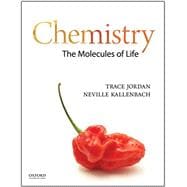Chemistry: The Molecules of Life emphasizes the fundamentals of chemistry to create a foundation of knowledge and connects the content to students' lives with relevant and contemporary examples. This text encourages students to develop problem-solving skills with practice exercises, worked examples, and support material. Chemistry: The Molecules of Life engages students from all majors with a wide range of pedagogical features and demonstrates chemistry's relevance to everyday life.
Rather than presenting chemistry as an isolated discipline, Chemistry: The Molecules of Life emphasizes the importance of chemical knowledge for understanding the molecular basis of life, which is relevant to students' health, environment, and everyday experiences. This contextual focus promotes scientific literacy and helps students develop the critical thinking skills needed to evaluate scientific information presented in the media and make informed decisions about their personal well-being.








